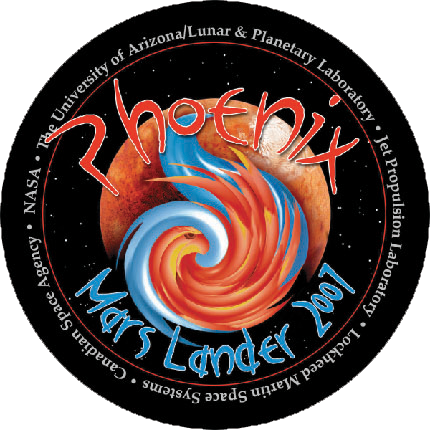Derived from he Phoenix public web site - http://phoenix.lpl.arizona.edu/science.php)
Overview
Discoveries made by the Mars Odyssey Orbiter in 2002 show large amounts of subsurface water ice in the northern arctic plain. The Phoenix lander targeted this circumpolar region using a robotic arm to dig through the protective topsoil layer to the water ice below and ultimately, to bring both soil and water ice to the lander platform for analysis.This map, centered on the north pole of Mars, is based on Odyssey’s detection of gamma rays from the element hydrogen--mainly in the form of water ice. Regions of high ice content are shown in violet and blue and those low in ice content are shown in red. The very ice-rich region at the pole is due to a permanent polar cap of water ice on the surface. Elsewhere in this region, the ice is buried under several to a few tens of centimeters of dry soil. (Image Credit: NASA/JPL/UA)
Science Goals
The Phoenix spacecraft and its scientific instruments were selected and designed to:Goal 1: Determine whether life ever arose on Mars -- Continuing the Viking missions' quest, but in an environment known to be water-rich, Phoenix searches for signatures of life at the soil-ice interface just below the Martian surface. Phoenix landed in the arctic plains, where its robotic arm dug through the dry soil, reached the ice layer, brought the soil and ice samples to the lander platform, and analyzed these samples using advanced scientific instruments.
Goal 2: Characterize the climate of Mars -- Phoenix landed during the retreat of the Martian polar cap, when cold soil was first exposed to sunlight after a long winter. The interaction between the ground surface and the Martian atmosphere that occurs at this time is critical to understanding the present and past climate of Mars. To gather data about this interaction and other surface meteorological conditions, Phoenix carried the first weather station in the Martian polar region. Data from this station will have a significant impact in improving global climate models of Mars.
Goal 3: Characterize the geology of Mars -- As on Earth, the past history of water is written below the surface because liquid water changes the soil chemistry and mineralogy in definite ways. Phoenix used a suite of chemistry experiments to thoroughly analyze the soil's chemistry and mineralogy. Using the first true microscope on Mars, Phoenix examined the structure of soil grains in an attempt to determine water's role on their formation.
Goal 4: Prepare for human exploration -- The Phoenix Mission provided evidence of water ice and assess the soil chemistry in Martian arctic. Understanding the soil chemistry will provide understanding of the potential resources available for human explorers to the northern plains.
Science Objectives
The Phoenix Mission has two bold objectives to support these goals:
Objective 1: Study the History of Water in All its Phases -- Currently, water on Mars' surface and atmosphere exists in two states: gas and solid. At the poles, the interaction between the solid water ice at and just below the surface and the gaseous water vapor in the atmosphere is believed to be critical to the weather and climate of Mars. Phoenix was the first mission to collect meteorological data in the Martian arctic needed by scientists to model Mars' past climate and predict future weather processes.
Objective 2: Search for Evidence of Habitable Zone and Assess the Biological Potential of the Ice-Soil Boundary -- Recent discoveries have shown that life can exist in the most extreme conditions. Indeed, it is possible that bacterial spores can lie dormant in bitterly cold, dry, and airless conditions for millions of years and become activated once conditions become favorable. Such dormant microbial colonies may exist in the Martian arctic, where due to the periodic wobbling of the planet, liquid water may exist for brief periods about every 100,000 years making the soil environment habitable.
Despite having the proper ingredients to sustain life, the Martian soil may also contain hazards that prevent biological growth, such as powerful oxidants that break apart organic molecules. Powerful oxidants that can break apart organic molecules are expected in dry environments bathed in UV light, such as the surface of Mars. But a few inches below the surface, the soil could protect organisms from the harmful solar radiation. Phoenix was designed to dig deep enough into the soil to analyze the soil environment potentially protected from UV looking for organic signatures and potential habitability.
Scientific Measurement
The following table shows the relationships between Phoenix's science objectives, the scientific measurements to be made, and the instruments that will make these measurements.

 PDS: The Planetary Atmospheres Node
PDS: The Planetary Atmospheres Node



